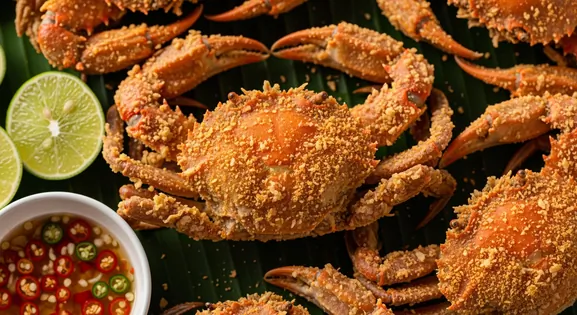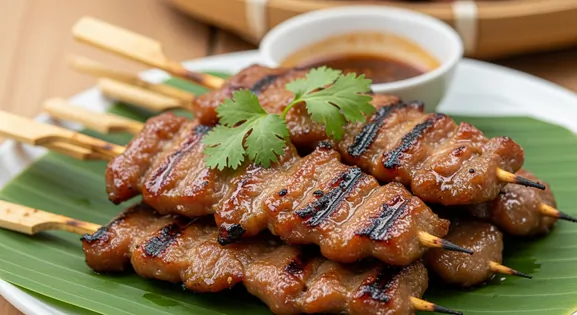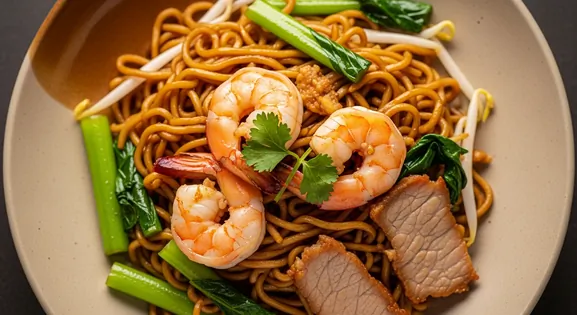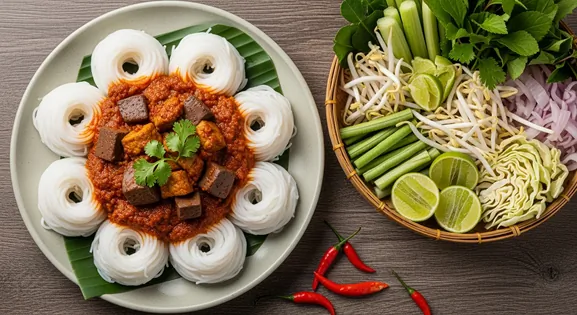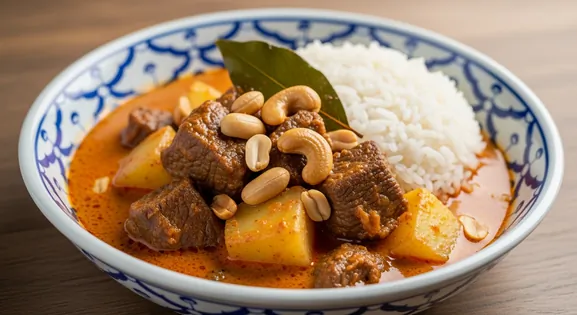Braised Pork Leg in Phuket
ขาหมูพะโล้ (Kha Moo Palo)
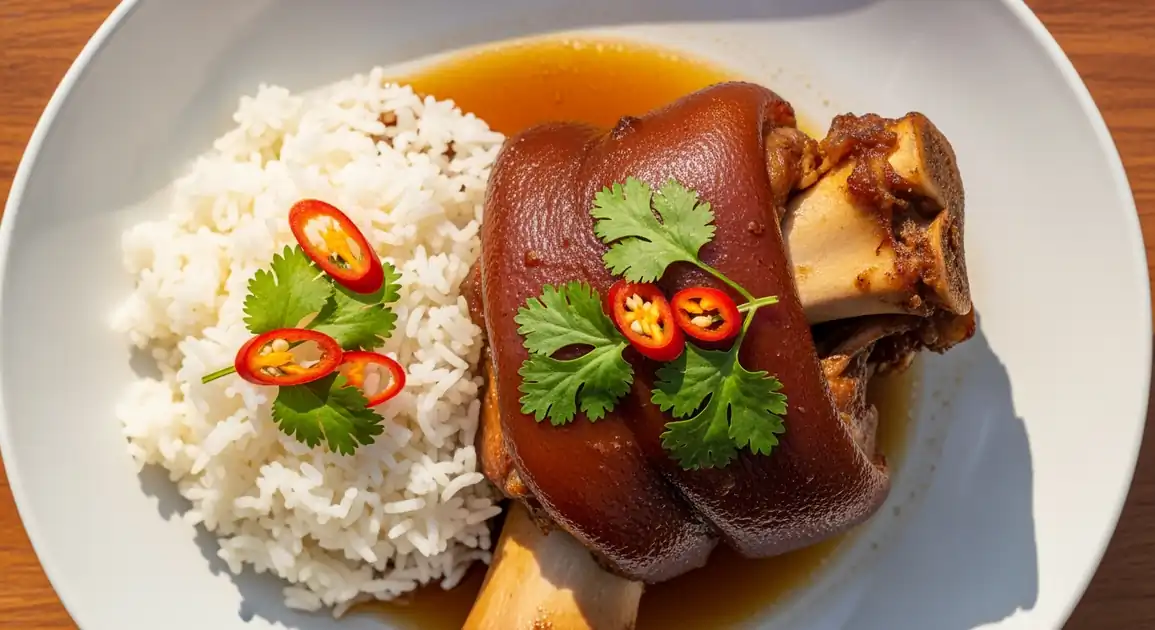
Discovering Authentic Braised Pork Leg
Stepping into Phuket's Old Town, the aroma of slow-braised pork leg is irresistible. This dish, deeply rooted in the island's Chinese-Peranakan history, offers a comforting, savory experience. From bustling markets to quaint shophouses, finding the perfect Kha Moo Palo here is a true culinary adventure.
New to Braised Pork Leg? Learn all about its history in our complete guide.
A Cultural Deep Dive
Local Significance
In Phuket, Kha Moo Palo reflects the island's strong Peranakan and Hokkien Chinese heritage, particularly visible in the Old Town's culinary traditions.
Eating Customs
- In Phuket, the dish is sometimes enjoyed with additional local condiments like prik nam som (sour-spicy sauce).
- Local Phuket residents often order 'nam phrik' (chili dip) dishes to complement the richness of the pork.
- In more traditional settings, small shared plates of different proteins and vegetables accompany the dish.
Unique Preparations of Braised Pork Leg
Peranakan Influence
Some Phuket Town vendors incorporate Nyonya-inspired flavors with additional fragrant spices and slightly sweeter profiles.
Southern-Spiced Version
A spicier variation incorporating black pepper and sometimes a hint of southern Thai spice blends.
Traveler's Portion
Single-dish complete meals developed for tourists that include all components (pork, rice, egg, greens) on one plate for convenience.
Unlocking the Secrets of a Great Meal
Many of the best, most authentic Kha Moo Palo spots are hidden within the Sino-Portuguese shophouses of Phuket Old Town. Look for small, family-run eateries.
When ordering, use the full Thai name "Khao Kha Moo" (ข้าวขาหมู) to ensure you get the rice and pork leg together, as locals do.
Phuket locals often enjoy their Kha Moo Palo with a side of "prik nam som" (chili vinegar) or other local chili dips. Don't be afraid to ask for it.
Exploring Phuket for the Best Braised Pork Leg
Phuket Old Town
The historic center has several well-established pork leg vendors, many with Sino-Portuguese heritage and decades of experience.
Thalang Road, Dibuk Road, Soi Romanee, Thai Hua Museum
Lunch, Early Dinner
Local Markets
Fresh markets throughout the island feature food sections with quality pork leg vendors.
Downtown Market, Banzaan Fresh Market, Weekend Market
Morning, Lunch
Patong
Even in this tourist hub, you can find authentic versions by seeking out places catering to local workers.
Malin Plaza, Back roads away from beach, OTOP Shopping Paradise
Lunch, Dinner
Vendor Tips
- In Phuket, vendors with Hokkien Chinese background (indicated by signs or menu items) often excel at this dish.
- Look for places displaying 'Baba' or 'Peranakan' signage, as these cultural backgrounds often produce excellent Kha Moo Palo.
- Phuket locals often recommend places by saying 'mua rue' (delicious) - follow their lead.
A Traveler's Checklist
What to Look For
-
Pork kept visibly simmering in hot braising liquid.
Crucial for food safety, especially in Phuket's humid climate.
-
Meat carved fresh upon ordering.
Ensures freshness and proper temperature, avoid pre-cut piles.
-
Clean stall appearance, particularly cutting board and knife.
A visibly clean preparation area, including the cutting board and knives, indicates a vendor's commitment to good hygiene practices.
-
Busy stalls in local markets (e.g., Phuket Town morning/night markets) or established local eateries.
High customer turnover ensures ingredients are fresh and constantly replenished, reducing the chance of food sitting out too long.
What to avoid
-
Pre-cut pork sitting out at ambient temperature.
In Phuket's tropical climate, meat left at room temperature for extended periods can quickly become a concern for freshness and quality.
-
Braising liquid not actively simmering or looking cool/greasy.
The braising liquid should be consistently hot, as this is key to maintaining the pork's temperature and ensuring its quality.
-
Stalls with obvious hygiene issues or pests.
Observe the overall cleanliness of the stall and surrounding area; visible pests or unkempt conditions are clear indicators to avoid.
-
Tourist-focused restaurants offering it as one of many dishes (quality might be less specialized).
For the most authentic and high-quality experience, prioritize vendors who specialize in Kha Moo Palo rather than those with extensive, generic menus.
The Traveler's Essentials
Dietary Information
Important Note for Travelers: Your safety is our priority. Below are the common allergens associated with the traditional preparation of this dish. However, recipes and ingredients can vary significantly between establishments. Always confirm all ingredients directly with the food vendor before ordering, especially if you have a severe allergy.
Potential Allergens
Dietary Suitability
Price Guide
Budget Tips
- Local markets like Phuket Town Fresh Market offer the best value at 50-80 THB per plate.
- Old Town shophouse eateries often provide excellent quality at mid-range prices (70-120 THB).
- Beachside restaurants in tourist areas charge premium prices (150-220 THB) for essentially the same dish.
- Look for lunch specials in local shops which often include a drink for 80-100 THB.
Serving & Seasonality
In Phuket, often served on ceramic plates in Old Town establishments or disposable containers at markets and street stalls. Typically accompanied by a small dish of vinegar-chili sauce and sometimes Chinese pickled vegetables.Best Times to Enjoy
- Lunch: Most popular time, when locals frequent pork leg vendors.
- Dinner: Common in night markets and evening food zones.
Seasonal Availability
Available year-round with consistent quality.
The Art of Ordering
When ordering Kha Moo Palo in Phuket, specify your preference for meat: 'Nang' (skin), 'Neua' (lean meat), 'Pasom' (mix), or 'Kakhi' (trotter). Most places serve it with rice and a braised egg; ask for 'Kai Tom' if not offered. Don't hesitate to ask for extra 'nam jim' (dipping sauce), often a tangy chili-vinegar. In local eateries, you might also find 'pak gat dong' (pickled mustard greens) as a side.
Step-by-Step Guides
Finding Kha Moo Palo in Phuket Town
Locate places serving braised pork leg in the heart of Phuket.
- Explore Phuket Town's Old Town area and local markets (e.g., Downtown Market, weekend night market).
- Look for shophouse eateries or street stalls displaying 'Khao Kha Moo' (ข้าวขาหมู).
- Seek out spots popular with locals, often found slightly away from the main tourist drags on streets like Rassada Rd or Dibuk Rd.
- Ask locals or hotel staff for recommendations for authentic Phuket-style versions.
- Be aware that Southern Thai style might sometimes incorporate more pepper or local spices.
Ordering Khao Kha Moo on the Island
Get your braised pork leg fix in Phuket.
- Order 'Khao Kha Moo'.
- Request fatty skin ('Nang'), lean meat ('Neua'), or a mix ('Pasom'). Trotter ('Kakhi') may also be available.
- Ask for a braised egg ('Kai Tom').
- It's typically served with rice, pickled greens, and a chili-vinegar sauce.
- Prices might be slightly higher in Phuket compared to Bangkok or Chiang Mai.
Our Commitment to Quality
At Tasteplorers, our mission is to provide the most accurate and useful travel information in the world. To achieve this, all content on this site is created through our unique editorial framework. We utilize leading AI research tools, guided by our proprietary prompts, and a multi-stage validation process. This entire system is overseen by our editorial team to ensure everything we publish meets our high standards for accuracy, cultural nuance, and practical value for travelers.
Learn more about our Editorial Process and our Mission.
Countries
Explore regions
Europe
Discover Europe's diverse culinary landscape, from Mediterranean flavors to hearty Alpine fare. Learn to navigate markets, decode menus, and eat like a local.
Latin America & Caribbean
Discover the vibrant cuisines of Latin America & the Caribbean. Our expert guide covers everything from Mexican street food to Peruvian ceviche and market tips.
Oceania
Explore Oceania's diverse food scene. Learn about Polynesian earth ovens, Fijian feasts, and the vibrant café culture of Australia and New Zealand.
Southeast Asia
Explore Southeast Asia's diverse food cultures from Thailand to Vietnam. Get expert tips on navigating spice levels, choosing quality vendors, and understanding the rich traditions of the region.
